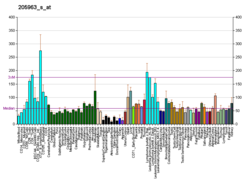DNAJA3
DNAJA3DnaJ homological subfamily A멤버 3 미토콘드리아(Thomochondrial, TID1)는 인간에서 16번 염색체의 DNAJA3 유전자에 의해 인코딩되는 단백질이다.[5][6][7] 이 단백질은 DNAJ/Hsp40 단백질군에 속하며, Hsp70 샤페론 단백질을 결합·활성화시켜 단백질 접힘, 분해, 복잡한 조립을 하는 것으로 알려져 있다.[6][7][8] 미토콘드리아 단백질로서 세포 이동, 성장, 사망 등의 세포 과정뿐만 아니라 막 전위 및 미토콘드리아 DNA(mtDNA) 무결성 유지에 관여한다.[6][7][9][10][11] 나아가 신경퇴행성질환, 염증성질환, 암 등 광범위한 질병과 연관되어 있다.[7][9][11][12]
구조
DNAJ/Hsp40 단백질 계열의 일원으로서 DNAJA3에는 보존된 DnaJ 도메인이 포함되어 있는데, 여기에는 Hsp70과 상호 작용하여 코커페론 기능을 수행하는 HPD 모티브가 포함되어 있다.[6][7][8][9][10] DnaJ 영역은 두 나선 사이에 위치한 히스티딘, 프롤라인, 아스파르트산의 3중주를 포함하는 사차원 영역으로 구성되어 있다. 또한 이 단백질에는 글리신/페닐알라닌(G/F) 리치 링커 부위와 아연 핑거 반복과 유사한 중심 사이스테인이 풍부한 부위가 들어 있는데, 두 가지 모두 타입 I DNAJ 분자 샤페론의 특징이다.[8][9][10] N단자에서의 미토콘드리아 표적 배열은 단백질의 국산화 과정을 미토콘드리아 매트릭스로 유도한다.[8][9][10]
DNAJA3는 대안으로 분할된 두 가지 형태, 즉 43kDa의 긴 이소 형태와 40kDa의 짧은 이소 형태를 가지고 있다.[6][7][9][12] 긴 이소폼은 짧은 이소폼에 비해 C단자에 33개의 잔류물을 추가로 함유하고 있으며, 이 부위는 긴 이소폼이 막 전위를 조절하는 것을 방해할 것으로 예측된다.[7]
함수
DNAJA3는 DNAJ/Hsp40 단백질 계열의 일원으로, Hsp70 체패론의 ATPase 활성을 자극하고 단백질 접힘, 분해, 다단백질 복합체 조립에 중요한 역할을 한다.[6][7][8] DNAJA3는 미토콘드리아에 국부화하여 미토콘드리아 Hsp70 샤페론(mtHsp70)과 상호 작용하여 샤페론 시스템을 수행한다.[6][7] 이 단백질은 mtDNA를 유지하기 위한 메커니즘은 아직 알려져 있지 않지만 복잡한 I 집계의 규제를 통해 mtDNA의 균일한 분포와 mtDNA의 무결성을 유지하는 데 중요하다.[7] 그런 다음 이 기능들은 DNAJA3가 DRP1을 통한 미토콘드리아 핵분열과 세포 이동, 성장, 증식, 분화, 노화, 사멸과 같은 세포 과정을 중재할 수 있도록 한다.[6][7][9][10][11] 그러나, DNAJA3의 두 등소 형태는 세포 생존과 관련되어 있지만, 두 개의 반대되는 결과에도 영향을 미치는 것으로 관찰된다. 프로포토틱스 롱 이소폼은 미토콘드리아에서 시토크롬 C 방출을 자극하고 카스파아제 활성화를 유도하는 반면, 안티포토틱스 쇼트 이소폼은 시토크롬 C 방출을 막아 사포화를 유도한다.[7][11] 신경근 접합에서는 오직 짧은 이소성형만이 효율적인 시냅스 전달을 위해 아세틸콜린 수용체를 구성한다.[7] 두 개의 이소형식은 또한 그들의 특정한 미토콘드리아 국산화에서도 서로 다른 기능을 부분적으로 설명할 수 있다.[7][11]
미토콘드리아에 대한 국산화 이전에 DNAJA3는 일시적으로 시토솔에 보존되는데, 여기서도 시토솔 단백질과 상호작용을 할 수 있고 이러한 단백질을 운반하는 기능을 할 수 있다.[8][11]
임상적 유의성
이 단백질은 피부암, 유방암, 대장암 등 여러 암에 관여한다.[12] ErbB2와 p53 종양 억제 단백질 등 종양 유발 단백질과의 상호작용을 통한 종양 억제 핵심 플레이어다.[6][8] 저산소 조건에서 DNAJA3는 MDM2와 같은 유비쿼티틴 리깅스를 통해 p53 복합체 조립이나 개조 등에 직접 영향을 미치거나 간접적으로 유비쿼티비닐 p53을 이용할 수 있다. 더욱이 세포 내 세포사멸을 유도하기 위해서는 p53과 DNAJA3가 모두 미토콘드리아에 존재해야 한다.[8] 머리와 목의 편평한 세포암(HNSC) 암에서 DNAJA3는 EGFR을 완화하고 신호 경로 하류인 AKT를 감소시킴으로써 세포증식, 앵커리지 독립 성장, 세포 운동성, 세포 침입을 억제한다.[12] 따라서 DNAJA3의 발현과 기능을 촉진하는 치료법은 종양의 제거에 크게 도움이 될 수 있다.[8]
또한 DNAJA3는 mtHsp70과 연계하여 미토콘드리아 단백질을 보호하고 미토콘드리아 형태학을 매개하는 주요 역할 때문에 파킨슨병 같은 신경퇴행성 질환에 연루되어 있다.[7][9] 또 다른 질환인 건선은 만성 염증성 피부질환으로, 그 결과 MK5의 활성화, HSP27의 인산화 증가, 액틴 시토스켈레톤 조직 증가, 과염성 피부 등이 발생한다.[11]
상호작용
DNAJA3는 다음과 상호작용하는 것으로 나타났다.
참조
- ^ a b c ENSG00000103423 GRCh38: 앙상블 릴리스 89: ENSG00000276726, ENSG00000103423 - 앙상블, 2017년 5월
- ^ a b c GRCm38: 앙상블 릴리스 89: ENSMUSG00000004069 - 앙상블, 2017년 5월
- ^ "Human PubMed Reference:". National Center for Biotechnology Information, U.S. National Library of Medicine.
- ^ "Mouse PubMed Reference:". National Center for Biotechnology Information, U.S. National Library of Medicine.
- ^ Schilling B, De-Medina T, Syken J, Vidal M, Munger K (August 1998). "A novel human DnaJ protein, hTid-1, a homolog of the Drosophila tumor suppressor protein Tid56, can interact with the human papillomavirus type 16 E7 oncoprotein". Virology. 247 (1): 74–85. doi:10.1006/viro.1998.9220. PMID 9683573.
- ^ a b c d e f g h i "Entrez Gene: DNAJA3 DnaJ (Hsp40) homolog, subfamily A, member 3".
- ^ a b c d e f g h i j k l m n o p Ng, AC; Baird, SD; Screaton, RA (April 2014). "Essential role of TID1 in maintaining mitochondrial membrane potential homogeneity and mitochondrial DNA integrity". Molecular and Cellular Biology. 34 (8): 1427–37. doi:10.1128/mcb.01021-13. PMC 3993590. PMID 24492964.
- ^ a b c d e f g h i Ahn, BY; Trinh, DL; Zajchowski, LD; Lee, B; Elwi, AN; Kim, SW (25 February 2010). "Tid1 is a new regulator of p53 mitochondrial translocation and apoptosis in cancer". Oncogene. 29 (8): 1155–66. doi:10.1038/onc.2009.413. PMID 19935715.
- ^ a b c d e f g h Elwi, AN; Lee, B; Meijndert, HC; Braun, JE; Kim, SW (August 2012). "Mitochondrial chaperone DnaJA3 induces Drp1-dependent mitochondrial fragmentation". The International Journal of Biochemistry & Cell Biology. 44 (8): 1366–76. doi:10.1016/j.biocel.2012.05.004. PMID 22595283.
- ^ a b c d e f Trinh, DL; Elwi, AN; Kim, SW (October 2010). "Direct interaction between p53 and Tid1 proteins affects p53 mitochondrial localization and apoptosis". Oncotarget. 1 (6): 396–404. doi:10.18632/oncotarget.100902 (inactive 31 October 2021). PMC 3248115. PMID 21311096.
{{cite journal}}: CS1 maint : 2021년 10월 현재 DOI 비활성화(링크) - ^ a b c d e f g h Choi, JH; Choi, DK; Sohn, KC; Kwak, SS; Suk, J; Lim, JS; Shin, I; Kim, SW; Lee, JH; Joe, CO (27 July 2012). "Absence of a human DnaJ protein hTid-1S correlates with aberrant actin cytoskeleton organization in lesional psoriatic skin". The Journal of Biological Chemistry. 287 (31): 25954–63. doi:10.1074/jbc.m111.313809. PMC 3406679. PMID 22692211.
- ^ a b c d Chen, CY; Chiou, SH; Huang, CY; Jan, CI; Lin, SC; Hu, WY; Chou, SH; Liu, CJ; Lo, JF (November 2009). "Tid1 functions as a tumour suppressor in head and neck squamous cell carcinoma". The Journal of Pathology. 219 (3): 347–55. doi:10.1002/path.2604. PMID 19681071. S2CID 23405415.
- ^ a b Sarkar S, Pollack BP, Lin KT, Kotenko SV, Cook JR, Lewis A, Pestka S (December 2001). "hTid-1, a human DnaJ protein, modulates the interferon signaling pathway". J. Biol. Chem. 276 (52): 49034–42. doi:10.1074/jbc.M103683200. PMID 11679576.
- ^ Trentin GA, Yin X, Tahir S, Lhotak S, Farhang-Fallah J, Li Y, Rozakis-Adcock M (April 2001). "A mouse homologue of the Drosophila tumor suppressor l(2)tid gene defines a novel Ras GTPase-activating protein (RasGAP)-binding protein". J. Biol. Chem. 276 (16): 13087–95. doi:10.1074/jbc.M009267200. PMID 11116152.
추가 읽기
- Maruyama K, Sugano S (1994). "Oligo-capping: a simple method to replace the cap structure of eukaryotic mRNAs with oligoribonucleotides". Gene. 138 (1–2): 171–4. doi:10.1016/0378-1119(94)90802-8. PMID 8125298.
- Suzuki Y, Yoshitomo-Nakagawa K, Maruyama K, et al. (1997). "Construction and characterization of a full length-enriched and a 5'-end-enriched cDNA library". Gene. 200 (1–2): 149–56. doi:10.1016/S0378-1119(97)00411-3. PMID 9373149.
- Syken J, De-Medina T, Münger K (1999). "TID1, a human homolog of the Drosophila tumor suppressor l(2)tid, encodes two mitochondrial modulators of apoptosis with opposing functions". Proc. Natl. Acad. Sci. U.S.A. 96 (15): 8499–504. Bibcode:1999PNAS...96.8499S. doi:10.1073/pnas.96.15.8499. PMC 17545. PMID 10411904.
- Shinohara M, Gasior SL, Bishop DK, Shinohara A (2000). "Tid1/Rdh54 promotes colocalization of rad51 and dmc1 during meiotic recombination". Proc. Natl. Acad. Sci. U.S.A. 97 (20): 10814–9. Bibcode:2000PNAS...9710814S. doi:10.1073/pnas.97.20.10814. PMC 27106. PMID 11005857.
- Trentin GA, Yin X, Tahir S, et al. (2001). "A mouse homologue of the Drosophila tumor suppressor l(2)tid gene defines a novel Ras GTPase-activating protein (RasGAP)-binding protein". J. Biol. Chem. 276 (16): 13087–95. doi:10.1074/jbc.M009267200. PMID 11116152.
- Ohtsuka K, Hata M (2001). "Mammalian HSP40/DNAJ homologs: cloning of novel cDNAs and a proposal for their classification and nomenclature". Cell Stress Chaperones. 5 (2): 98–112. doi:10.1379/1466-1268(2000)005<0098:MHDHCO>2.0.CO;2. ISSN 1466-1268. PMC 312896. PMID 11147971.
- Sarkar S, Pollack BP, Lin KT, et al. (2002). "hTid-1, a human DnaJ protein, modulates the interferon signaling pathway". J. Biol. Chem. 276 (52): 49034–42. doi:10.1074/jbc.M103683200. PMID 11679576.
- Yin X, Rozakis-Adcock M (2002). "Genomic organization and expression of the human tumorous imaginal disc (TID1) gene". Gene. 278 (1–2): 201–10. doi:10.1016/S0378-1119(01)00720-X. PMID 11707338.
- Cheng H, Cenciarelli C, Shao Z, et al. (2002). "Human T cell leukemia virus type 1 Tax associates with a molecular chaperone complex containing hTid-1 and Hsp70". Curr. Biol. 11 (22): 1771–5. doi:10.1016/S0960-9822(01)00540-1. PMID 11719219. S2CID 17461974.
- Cheng H, Cenciarelli C, Tao M, et al. (2002). "HTLV-1 Tax-associated hTid-1, a human DnaJ protein, is a repressor of Ikappa B kinase beta subunit". J. Biol. Chem. 277 (23): 20605–10. doi:10.1074/jbc.M201204200. PMID 11927590.
- Wang Y, Han KJ, Pang XW, et al. (2002). "Large scale identification of human hepatocellular carcinoma-associated antigens by autoantibodies". J. Immunol. 169 (2): 1102–9. doi:10.4049/jimmunol.169.2.1102. PMID 12097419.
- Sasaki S, Nakamura T, Arakawa H, et al. (2002). "Isolation and characterization of a novel gene, hRFI, preferentially expressed in esophageal cancer". Oncogene. 21 (32): 5024–30. doi:10.1038/sj.onc.1205627. PMID 12118383.
- Strausberg RL, Feingold EA, Grouse LH, et al. (2003). "Generation and initial analysis of more than 15,000 full-length human and mouse cDNA sequences". Proc. Natl. Acad. Sci. U.S.A. 99 (26): 16899–903. Bibcode:2002PNAS...9916899M. doi:10.1073/pnas.242603899. PMC 139241. PMID 12477932.
- Syken J, Macian F, Agarwal S, et al. (2003). "TID1, a mammalian homologue of the drosophila tumor suppressor lethal(2) tumorous imaginal discs, regulates activation-induced cell death in Th2 cells". Oncogene. 22 (30): 4636–41. doi:10.1038/sj.onc.1206569. PMID 12879007.
- Rodriguez M, Yu X, Chen J, Songyang Z (2004). "Phosphopeptide binding specificities of BRCA1 COOH-terminal (BRCT) domains". J. Biol. Chem. 278 (52): 52914–8. doi:10.1074/jbc.C300407200. PMID 14578343.
- Ota T, Suzuki Y, Nishikawa T, et al. (2004). "Complete sequencing and characterization of 21,243 full-length human cDNAs". Nat. Genet. 36 (1): 40–5. doi:10.1038/ng1285. PMID 14702039.
- Lo JF, Hayashi M, Woo-Kim S, et al. (2004). "Tid1, a cochaperone of the heat shock 70 protein and the mammalian counterpart of the Drosophila tumor suppressor l(2)tid, is critical for early embryonic development and cell survival". Mol. Cell. Biol. 24 (6): 2226–36. doi:10.1128/MCB.24.6.2226-2236.2004. PMC 355836. PMID 14993262.
- Edwards KM, Münger K (2004). "Depletion of physiological levels of the human TID1 protein renders cancer cell lines resistant to apoptosis mediated by multiple exogenous stimuli". Oncogene. 23 (52): 8419–31. doi:10.1038/sj.onc.1207732. PMID 15156195.
- Colland F, Jacq X, Trouplin V, et al. (2004). "Functional proteomics mapping of a human signaling pathway". Genome Res. 14 (7): 1324–32. doi:10.1101/gr.2334104. PMC 442148. PMID 15231748.










